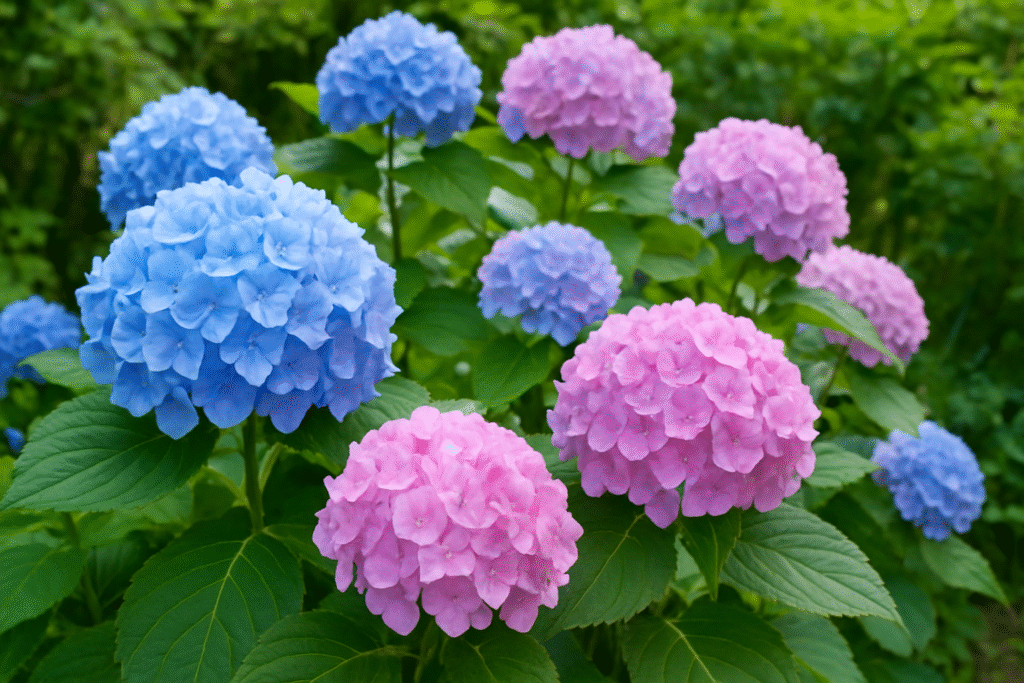Introduction
The Hydrangea plant is one of the most graceful and eye-catching flowering shrubs that can completely transform your garden. Known for its lush, globe-shaped clusters of flowers, this plant captures attention with its beauty and color variations. Whether pink, blue, white, or purple, Hydrangeas are the heart of every ornamental garden.Belonging to the family Hydrangeaceae, this plant has nearly 70 species spread across Asia and North America. Its ability to adapt to various soils and climates makes it a favorite among gardeners worldwide. The most fascinating fact about this plant is that its flower color changes depending on the soil pH — a magical feature that makes Hydrangea truly special.
Origin and Botanical Overview
Hydrangeas are native to Japan, China, and Korea, but they have spread across the globe due to their striking appearance and easy adaptability. The scientific name of the common garden Hydrangea is Hydrangea macrophylla, which literally means “large-leaved water lover.”
Hydrangeas are perennial plants that can live and bloom year after year. Their large green leaves and clusters of flowers create an impressive display during spring and summer seasons.

Popular Types of Hydrangeas
Hydrangeas come in several varieties, each with its unique size, shape, and color. Let’s look at some of the most popular ones:
1. Bigleaf Hydrangea (Hydrangea macrophylla)
This is the most commonly grown Hydrangea with round clusters of colorful blooms. It comes in two forms — mophead (rounded clusters) and lacecap (flat, delicate clusters).
2. Panicle Hydrangea (Hydrangea paniculata)
Recognized by its cone-shaped flowers, this variety can tolerate more sunlight and heat compared to others. The flowers often change from white to pink as they mature.
3. Smooth Hydrangea (Hydrangea arborescens)
Native to North America, this type produces large white blooms and is extremely hardy, surviving both heat and cold.
4. Oakleaf Hydrangea (Hydrangea quercifolia)
This variety is admired for its oak-shaped leaves and long-lasting flowers. In autumn, the foliage turns shades of red and bronze, adding seasonal interest.
5. Climbing Hydrangea (Hydrangea anomala)
Unlike other types, this Hydrangea grows as a vine and can cover walls, fences, or trees, giving a natural, romantic look to gardens.
How to Grow Hydrangea Plant
Choosing the Right Spot
Hydrangeas love bright but indirect sunlight. They grow best in partial shade, especially morning sun and afternoon shade. Full sun can scorch their delicate leaves and cause the blooms to fade quickly.
Soil Requirements
The secret behind healthy Hydrangeas lies in the soil. They prefer rich, well-draining soil with plenty of organic matter. Interestingly, the soil pH affects the flower color:
- Acidic soil (pH below 6) = Blue blooms
- Neutral soil (pH 6–7) = Purple blooms
- Alkaline soil (pH above 7) = Pink blooms
Planting Steps
- Dig a hole twice as wide as the root ball and just as deep.
- Place the plant carefully and fill it with garden soil mixed with compost.
- Water deeply after planting.
- Add a layer of mulch to maintain moisture and protect roots.

Watering and Fertilizing
Hydrangeas have a high water demand, especially during the flowering period. However, they do not like soggy soil.
- Water 2–3 times a week during hot weather.
- Avoid overhead watering to prevent leaf diseases.
- Mulch around the base to retain soil moisture.
For fertilization, apply a balanced, slow-release fertilizer in spring. Too much nitrogen can lead to lush foliage but fewer flowers, so moderation is key.
Light and Temperature Requirements
Hydrangeas thrive in moderate sunlight and mild temperatures. The ideal temperature range is between 15°C to 28°C.
In regions with intense summer heat, shade cloth or partial covering is beneficial. During winter, protect roots with mulch or dried leaves to prevent frost damage.
Pruning and Maintenance
Pruning is essential to encourage new blooms and maintain shape. However, pruning time varies by type:
- Old wood bloomers (Bigleaf and Oakleaf Hydrangeas): Prune after flowering in summer.
- New wood bloomers (Panicle and Smooth Hydrangeas): Prune in late winter or early spring.
Always remove dead, diseased, or crossing branches to maintain good air circulation and plant health.
Flowering Season and Color Change
Hydrangeas bloom from late spring to early autumn, depending on the climate. The color-changing property makes them especially loved by gardeners. You can modify flower color naturally by adjusting the soil pH:
- For blue flowers, add aluminum sulfate to the soil.
- For pink flowers, add garden lime to increase alkalinity.
These color variations allow gardeners to create stunning landscapes with shades that complement each other.
Common Pests and Diseases
Like all plants, Hydrangeas can face some pest and disease challenges:
- Aphids – small insects that suck plant sap.
- Spider mites – common in dry, hot weather.
- Powdery mildew – appears as a white powder on leaves.
- Leaf spot – brown or black spots caused by fungi.
To prevent these problems, ensure proper spacing between plants, avoid overwatering, and regularly inspect leaves. Use natural treatments like neem oil spray if needed.
Propagation of Hydrangea
Hydrangeas can be propagated easily through stem cuttings or division.

Propagation through Cuttings
- Choose a healthy stem about 6 inches long.
- Remove lower leaves and dip the stem in rooting hormone.
- Plant it in a pot filled with moist soil or perlite.
- Keep it in a shaded spot until roots develop (around 3–4 weeks).
Once roots are strong, you can transplant it into the garden or a larger pot.
Hydrangea in Landscape Design
Hydrangeas are versatile and enhance both modern and classic garden styles. Some creative ways to use them include:
- Planting along fences or borders for color balance.
- Growing in large containers on patios or porches.
- Using as focal plants near entryways.
- Pairing with roses, hostas, or ferns for a textured look.
Their long-lasting blooms also make them perfect for bouquets and floral arrangements, both fresh and dried.
Seasonal Care Routine
| Season | Care Tips |
|---|---|
| Spring | Apply fertilizer, prune lightly, and prepare for new growth. |
| Summer | Water frequently, provide partial shade, and enjoy blooming. |
| Autumn | Stop fertilizing, remove faded flowers, and allow dormancy. |
| Winter | Protect roots with mulch; cover young plants from frost. |
Hydrangeas usually rest during winter, but with good winter protection, they return stronger each spring.
Benefits of Growing Hydrangea
- Aesthetic Beauty: Hydrangeas create a stunning display with their large, colorful blooms.
- Long Blooming Season: They flower for several months, keeping your garden lively.
- Low Maintenance: Once established, they need minimal care.
- Air Improvement: Like many plants, they help purify the surrounding air.
- Symbolism: Hydrangeas symbolize gratitude, grace, and beauty — often used in celebrations and gifts.
Tips for Beginners
- Avoid planting in full sun or complete shade.
- Keep soil consistently moist but not waterlogged.
- Check soil pH if you wish to control flower color.
- Avoid pruning at the wrong time; it can affect next year’s blooms.
- Don’t use strong chemical fertilizers.
Patience and observation are key — Hydrangeas reward care with breathtaking blooms.
Final Thoughts
The Hydrangea plant stands as a timeless favorite for garden lovers around the world. Its lush foliage, abundant blooms, and color-changing petals bring life, elegance, and a sense of peace to any outdoor space. With a balance of sunlight, water, and gentle pruning, Hydrangeas can flourish beautifully year after year.
Whether used in landscapes, containers, or floral decorations, this plant symbolizes grace, abundance, and renewal. Once you add Hydrangeas to your garden, you’ll understand why they’ve been adored for centuries by gardeners and flower enthusiasts alike.

